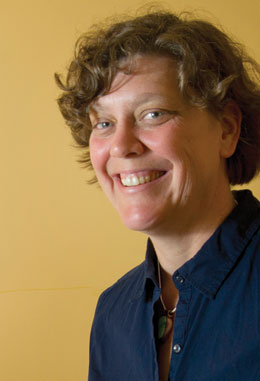Volume 30 · Number 4 · Summer 2013
The young and the inventive: Mary Cadenasso

Mary Cadenasso
(Photo by Karin Higgins/UC Davis)
Mary Cadenasso, associate professor of plant sciences
Education: Ph.D., Rutgers University, 1998; B.S., University of Santa Clara
Specialty: Urban ecology
Mary Cadenasso is exploring how to evaluate “land cover” in cities — looking at how different kinds of vegetation as well as man-made materials affect the ecology of cities.
Ultimately, her work has the potential to shift urban development discussions from being predominantly about “land use” to also addressing what materials should be used in development.
She began this work far from American urban centers, setting up a project in South Africa’s Kruger Park, to look at how different types of forests responded to dry spells along their rivers, and how this affected the movement of elephant herds, as well as nutrient cycles in the soil. From there, she adapted her research to the study of land cover in cities — how different kinds of vegetation, intermixed into the landscape of cities, affect temperature, the amount and toxicity of water run off, carbon storage, the presence or absence of shade, and so on.
“The overarching theme of my work,” she says, “is to try to understand the link between the structure of landscape and ecological function or processes.”
She has developed a new urban landscape classification system, HERCULES, which combines ecological analysis and urban design in working out optimal land covers for different settings.
Cadenasso believes that incorporating these findings into urban design classes will lead to an emphasis on rooftop gardens and, especially in cities with large numbers of abandoned buildings, vertical green walls. There the buildings themselves become the epicenter of creative gardening experiments.
“Urban ecology’s only 15 years old in the United States,” Cadenasso said. “We’re still learning about a lot of the processes in cities. How do we come up with solutions that are hybrids, instead of engineering our way out of problems?”
Longtime collaborator Steward Pickett, of the Cary Institute of Ecosystems Studies, in Millbrook, N.Y., said Cadenasso is developing “a novel way to look at land cover in urban areas. She’s been a leader in thinking about urban systems in a spatially integrated way. It’s a very thoughtful approach. Mary’s work is a good way forward. It stands out as something that can make urban ecology conceptually much cleaner.”
Back to The Young and the Inventive
